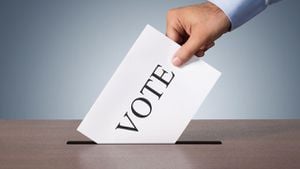Recent discussions surrounding opioid overdose trends reveal both alarming statistics and signs of hope. With the opioid crisis relentlessly affecting communities across the United States, public discourse often oscillates between highlighting the grim realities and examining potential reforms aimed at curbing this epidemic.
One notable development is the recent data from Washington D.C., which shows a marked decrease in opioid-related overdose deaths during the first half of 2024. The Office of the Chief Medical Examiner reported approximately 196 deaths from January to June, which is about 25% fewer than the same time frame last year, where fatalities reached 256. While these numbers might serve as tentative indicators of progress, officials remain cautious about declaring victory against what has long been considered one of the most pressing health crises affecting the nation.
Chief Medical Examiner Francisco J. Diaz underscored the devastating impact of the opioid crisis, noting how it has claimed more than 2,000 lives over the last five years. Despite the encouraging drop, Diaz expressed hope yet caution, indicating, “I would hope there is a ray of hope down the line. Whole communities have been completely decimated.” The complexity of drug policy reform makes it difficult for stakeholders, including policymakers and health professionals, to pinpoint the exact reasons behind the reduction.
Officials posited several potential contributors to this decline. The broad distribution of the overdose-reversing drug naloxone—often known by the brand name Narcan—alongside fentanyl testing strips, is believed to play pivotal roles. Harm-reduction advocates suggest other influences could include changing drug user demographics as the most vulnerable populations have been affected significantly by fentanyl and its potent derivatives.
Beyond D.C., there are national trends showing similar positive outcomes. The Centers for Disease Control and Prevention (CDC) released provisional data indicating overdose deaths nationwide fell by about 10% year-over-year as of April. This included figures from states such as Virginia and Maryland, which saw decreases of 15% and 6%, respectively. This wider reduction suggests the opioid crisis might be shifting at the community level, though the precise reasons remain unclear.
Simultaneously, debates continue surrounding political narratives related to the opioid epidemic. Former President Donald Trump recently made headlines with shocking claims about current Vice President Kamala Harris. During multiple rallies, he accused Harris of advocating for the legalization of fentanyl, stating, “Kamala is so radical, she even wants to legalize fentanyl,” highlighting the heightened tensions surrounding drug policy discourse. Trump’s supporters echoed his sentiments, expressing fears about the consequences of perceived lenient drug policies.
While Trump’s rhetoric seems to resonate with his base, it also ignores substantial data and existing policy frameworks. Harris’s actual policies have not included the legalization of fentanyl; rather, she has focused on broader criminal justice reforms and the decriminalization of marijuana. The politicization of drug policy not only complicates the substantive discussions needed to address opioid use but also may hinder the search for common ground among lawmakers. Harris's advocacy for reform aims to balance public safety with humane approaches to addiction treatment.
Kamala Harris has faced significant backlash from critics who believe her policies do not adequately address the opioid crisis. The recurring theme among her detractors is the insistence on tougher drug policies to combat the surge of overdose deaths rather than focusing on health-based approaches. Advocates for harm reduction, such as the D.C. Health Alliance Network, are emphatic about the need for more effective prevention programs, emphasizing the importance of evidence-based strategies over punitive measures.
Despite political bickering, local health departments are continuing to roll out new initiatives. The D.C. Department of Behavioral Health is utilizing federal funding targeting approximately $25 million annually to tackle the opioid crisis. With additional millions from opioid lawsuit settlements set to arrive over the next decade, stakeholders call for these funds to be allocated toward building treatment infrastructures. Ambrose Lane Jr., leader of the Health Alliance Network, expressed the urgent need for proper utilization of these funds to create sustainable treatment options.
Continuing the fight against opioid overdoses requires cooperation among lawmakers, health practitioners, and community advocates. The D.C. administration has highlighted its commitment to best practices, including educational programs and treatments like outpatient services for young patients struggling with addiction.
Still, many alarm bells ring. Reports show increasing rates of overdoses among specific demographics, including adolescents and Hispanics, with troubling trends noted among opioid use disorders across various communities. The dual nature of the crisis demands solutions not only targeted at those already affected but also those at risk of development.”
With the stakes so high, officials agree on the importance of constant vigilance and continued efforts to reduce overdose deaths, asserting, “This is certainly not the time to relax.” The statement perfectly summarizes the delicate balance between celebrating progress and recognizing the overarching challenges endemic to tackling the opioid crisis.
Ongoing assessments will be key as health officials strive to understand what works best. Equally important is to integrate insights from this fluctuative situation with national drug policies, maintaining advocacy for both recovery and prevention. Evaluations of Narcan distribution methods and outreach effectiveness will enable local governments to refine their responses to the epidemic and tailor strategies to fit community needs.
While preliminary data suggests some progress has been made, the opioid epidemic continues to serve as one of America’s most pressing public health challenges. Amid rising death tolls and political chatter surrounding the issue, it urges officials to align efforts effectively and work collectively to guide policies and interventions aimed at long-term treatment and reduction strategies. Continuous collaboration, funding, and research remain pivotal to creating viable solutions and lasting impacts as communities confront this multifaceted crisis.



